Financial Management Report: Rowlinson Knitwear Analysis
VerifiedAdded on 2023/01/13
|15
|4465
|85
Report
AI Summary
This report analyzes financial management concepts, using Rowlinson Knitwear as a case study. It examines the relationship between financial functions and other functional areas like production, marketing, and top management, and also explores the impact of financial objectives on decision-making, including profit maximization, return on investment, and cost minimization. The report differentiates between management and financial accounting, and it analyzes the impact of organizational and regulatory frameworks on financial management, including policies, governance, and compliance. Furthermore, it identifies challenges organizations face in accessing finance, such as time consumption and lack of goodwill. The report also differentiates between budget setting and financial forecasting, evaluates various budget setting approaches, develops a sample budget, and analyzes factors impacting budget management, including corrective actions and reporting procedures for budgetary variances.
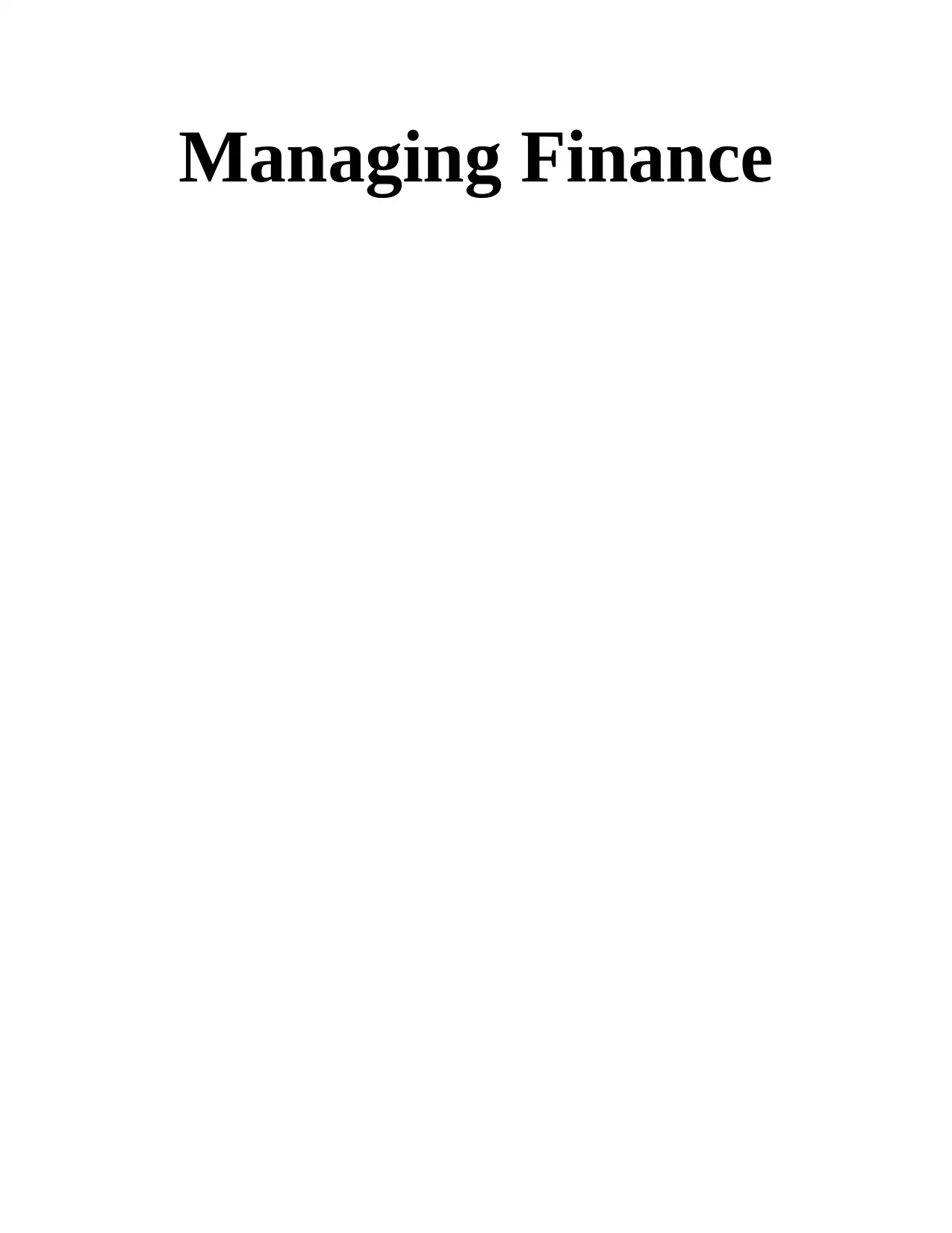
Managing Finance
Paraphrase This Document
Need a fresh take? Get an instant paraphrase of this document with our AI Paraphraser
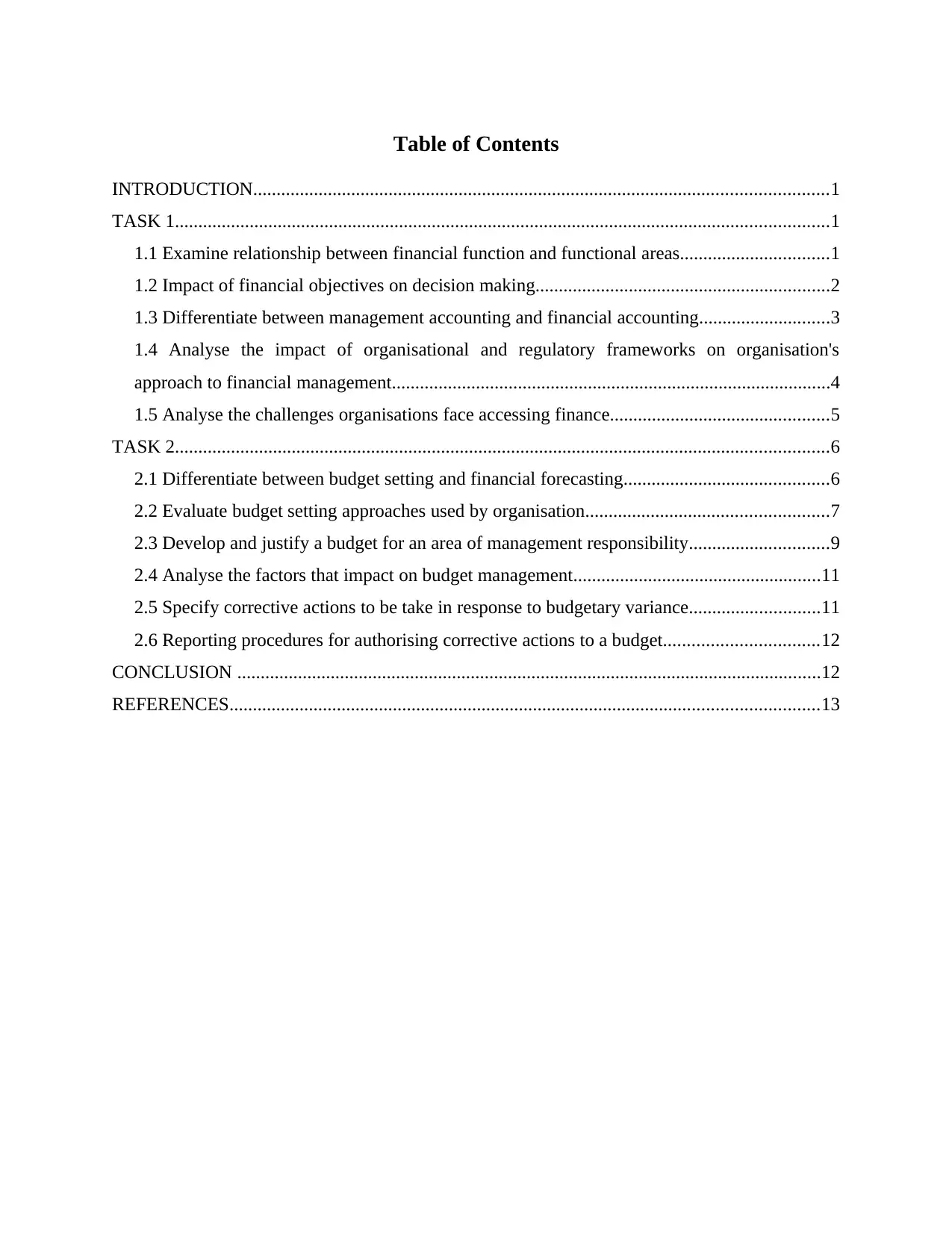
Table of Contents
INTRODUCTION...........................................................................................................................1
TASK 1............................................................................................................................................1
1.1 Examine relationship between financial function and functional areas................................1
1.2 Impact of financial objectives on decision making...............................................................2
1.3 Differentiate between management accounting and financial accounting............................3
1.4 Analyse the impact of organisational and regulatory frameworks on organisation's
approach to financial management..............................................................................................4
1.5 Analyse the challenges organisations face accessing finance...............................................5
TASK 2............................................................................................................................................6
2.1 Differentiate between budget setting and financial forecasting............................................6
2.2 Evaluate budget setting approaches used by organisation....................................................7
2.3 Develop and justify a budget for an area of management responsibility..............................9
2.4 Analyse the factors that impact on budget management.....................................................11
2.5 Specify corrective actions to be take in response to budgetary variance............................11
2.6 Reporting procedures for authorising corrective actions to a budget.................................12
CONCLUSION .............................................................................................................................12
REFERENCES..............................................................................................................................13
INTRODUCTION...........................................................................................................................1
TASK 1............................................................................................................................................1
1.1 Examine relationship between financial function and functional areas................................1
1.2 Impact of financial objectives on decision making...............................................................2
1.3 Differentiate between management accounting and financial accounting............................3
1.4 Analyse the impact of organisational and regulatory frameworks on organisation's
approach to financial management..............................................................................................4
1.5 Analyse the challenges organisations face accessing finance...............................................5
TASK 2............................................................................................................................................6
2.1 Differentiate between budget setting and financial forecasting............................................6
2.2 Evaluate budget setting approaches used by organisation....................................................7
2.3 Develop and justify a budget for an area of management responsibility..............................9
2.4 Analyse the factors that impact on budget management.....................................................11
2.5 Specify corrective actions to be take in response to budgetary variance............................11
2.6 Reporting procedures for authorising corrective actions to a budget.................................12
CONCLUSION .............................................................................................................................12
REFERENCES..............................................................................................................................13
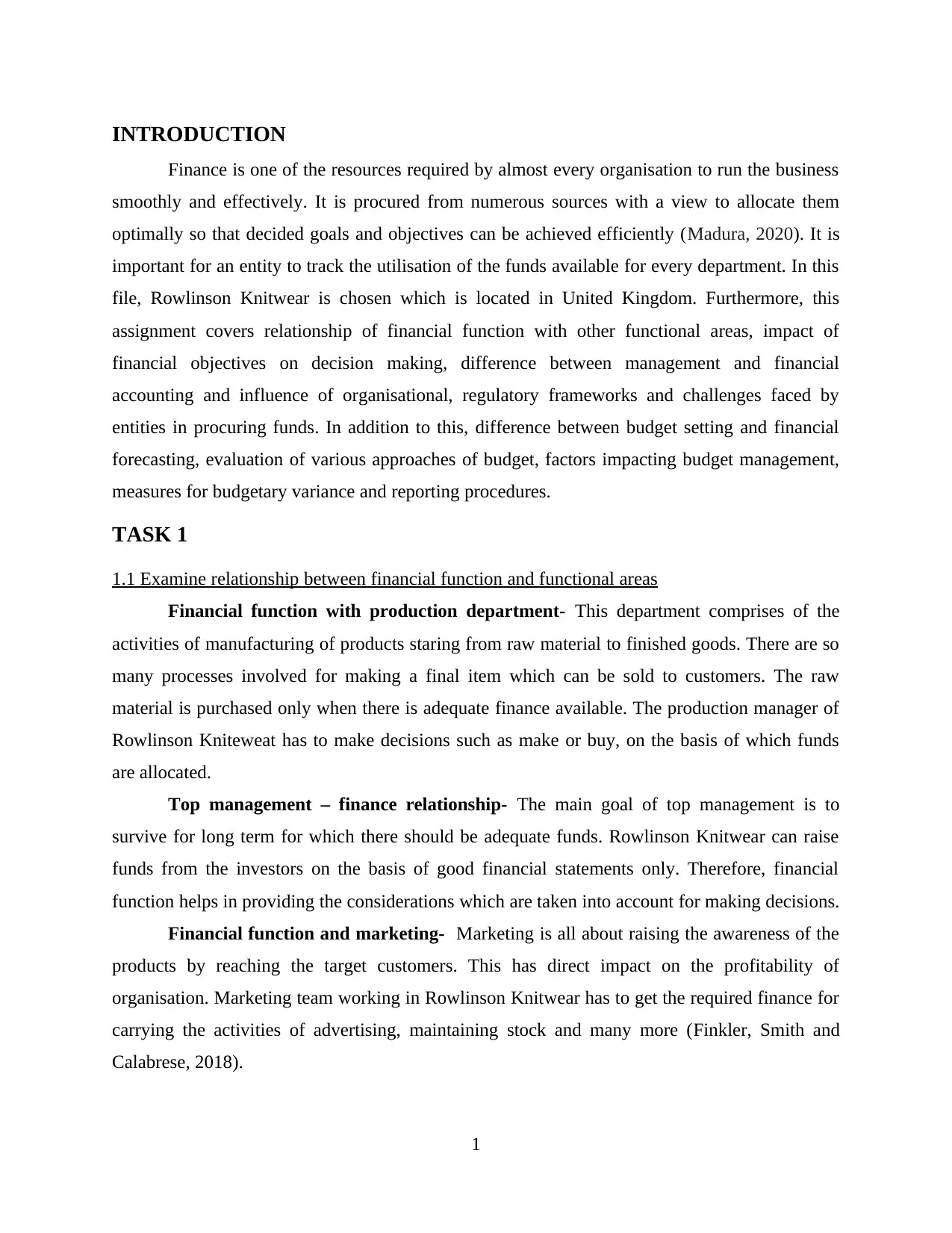
INTRODUCTION
Finance is one of the resources required by almost every organisation to run the business
smoothly and effectively. It is procured from numerous sources with a view to allocate them
optimally so that decided goals and objectives can be achieved efficiently (Madura, 2020). It is
important for an entity to track the utilisation of the funds available for every department. In this
file, Rowlinson Knitwear is chosen which is located in United Kingdom. Furthermore, this
assignment covers relationship of financial function with other functional areas, impact of
financial objectives on decision making, difference between management and financial
accounting and influence of organisational, regulatory frameworks and challenges faced by
entities in procuring funds. In addition to this, difference between budget setting and financial
forecasting, evaluation of various approaches of budget, factors impacting budget management,
measures for budgetary variance and reporting procedures.
TASK 1
1.1 Examine relationship between financial function and functional areas
Financial function with production department- This department comprises of the
activities of manufacturing of products staring from raw material to finished goods. There are so
many processes involved for making a final item which can be sold to customers. The raw
material is purchased only when there is adequate finance available. The production manager of
Rowlinson Kniteweat has to make decisions such as make or buy, on the basis of which funds
are allocated.
Top management – finance relationship- The main goal of top management is to
survive for long term for which there should be adequate funds. Rowlinson Knitwear can raise
funds from the investors on the basis of good financial statements only. Therefore, financial
function helps in providing the considerations which are taken into account for making decisions.
Financial function and marketing- Marketing is all about raising the awareness of the
products by reaching the target customers. This has direct impact on the profitability of
organisation. Marketing team working in Rowlinson Knitwear has to get the required finance for
carrying the activities of advertising, maintaining stock and many more (Finkler, Smith and
Calabrese, 2018).
1
Finance is one of the resources required by almost every organisation to run the business
smoothly and effectively. It is procured from numerous sources with a view to allocate them
optimally so that decided goals and objectives can be achieved efficiently (Madura, 2020). It is
important for an entity to track the utilisation of the funds available for every department. In this
file, Rowlinson Knitwear is chosen which is located in United Kingdom. Furthermore, this
assignment covers relationship of financial function with other functional areas, impact of
financial objectives on decision making, difference between management and financial
accounting and influence of organisational, regulatory frameworks and challenges faced by
entities in procuring funds. In addition to this, difference between budget setting and financial
forecasting, evaluation of various approaches of budget, factors impacting budget management,
measures for budgetary variance and reporting procedures.
TASK 1
1.1 Examine relationship between financial function and functional areas
Financial function with production department- This department comprises of the
activities of manufacturing of products staring from raw material to finished goods. There are so
many processes involved for making a final item which can be sold to customers. The raw
material is purchased only when there is adequate finance available. The production manager of
Rowlinson Kniteweat has to make decisions such as make or buy, on the basis of which funds
are allocated.
Top management – finance relationship- The main goal of top management is to
survive for long term for which there should be adequate funds. Rowlinson Knitwear can raise
funds from the investors on the basis of good financial statements only. Therefore, financial
function helps in providing the considerations which are taken into account for making decisions.
Financial function and marketing- Marketing is all about raising the awareness of the
products by reaching the target customers. This has direct impact on the profitability of
organisation. Marketing team working in Rowlinson Knitwear has to get the required finance for
carrying the activities of advertising, maintaining stock and many more (Finkler, Smith and
Calabrese, 2018).
1
⊘ This is a preview!⊘
Do you want full access?
Subscribe today to unlock all pages.

Trusted by 1+ million students worldwide
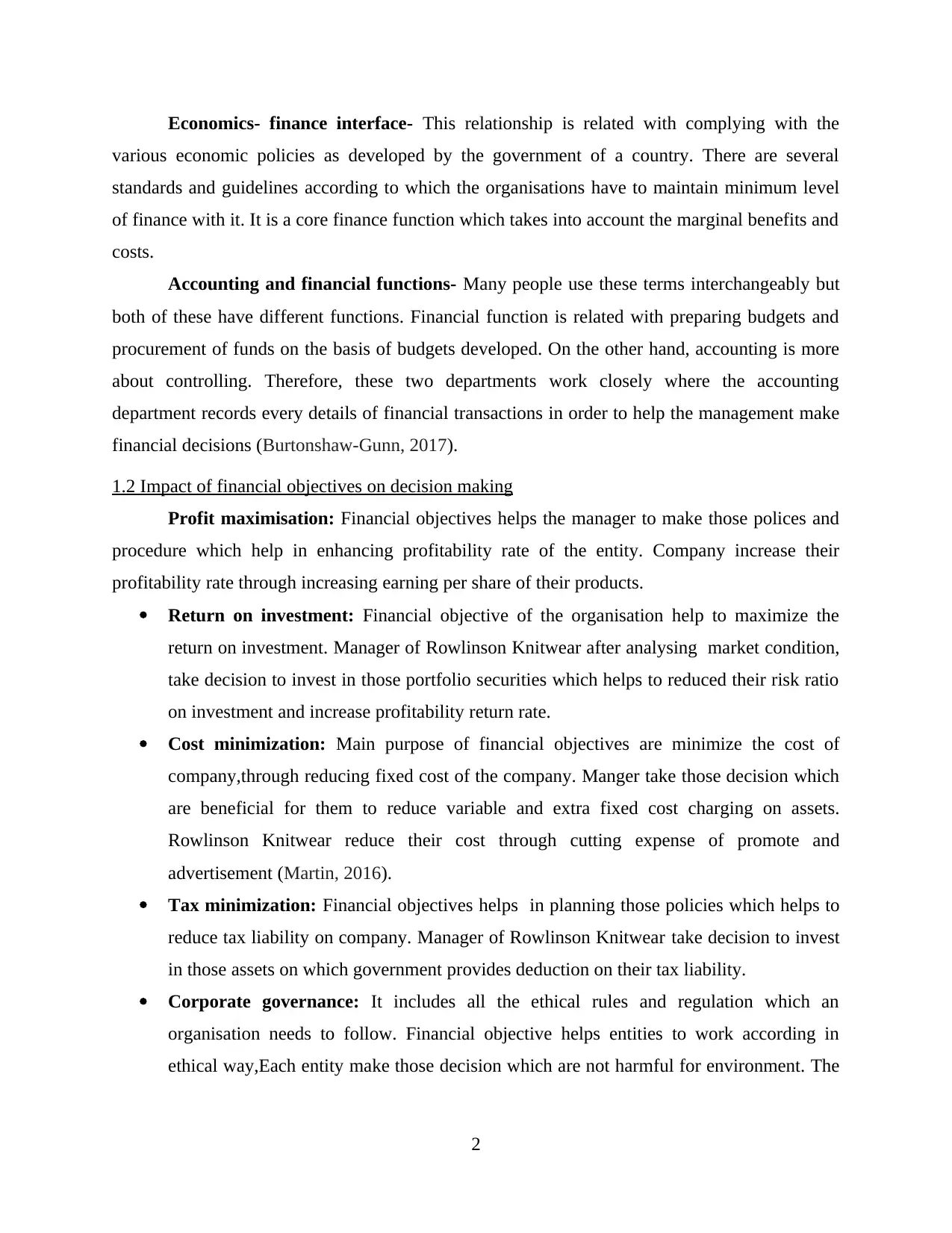
Economics- finance interface- This relationship is related with complying with the
various economic policies as developed by the government of a country. There are several
standards and guidelines according to which the organisations have to maintain minimum level
of finance with it. It is a core finance function which takes into account the marginal benefits and
costs.
Accounting and financial functions- Many people use these terms interchangeably but
both of these have different functions. Financial function is related with preparing budgets and
procurement of funds on the basis of budgets developed. On the other hand, accounting is more
about controlling. Therefore, these two departments work closely where the accounting
department records every details of financial transactions in order to help the management make
financial decisions (Burtonshaw-Gunn, 2017).
1.2 Impact of financial objectives on decision making
Profit maximisation: Financial objectives helps the manager to make those polices and
procedure which help in enhancing profitability rate of the entity. Company increase their
profitability rate through increasing earning per share of their products.
Return on investment: Financial objective of the organisation help to maximize the
return on investment. Manager of Rowlinson Knitwear after analysing market condition,
take decision to invest in those portfolio securities which helps to reduced their risk ratio
on investment and increase profitability return rate.
Cost minimization: Main purpose of financial objectives are minimize the cost of
company,through reducing fixed cost of the company. Manger take those decision which
are beneficial for them to reduce variable and extra fixed cost charging on assets.
Rowlinson Knitwear reduce their cost through cutting expense of promote and
advertisement (Martin, 2016).
Tax minimization: Financial objectives helps in planning those policies which helps to
reduce tax liability on company. Manager of Rowlinson Knitwear take decision to invest
in those assets on which government provides deduction on their tax liability.
Corporate governance: It includes all the ethical rules and regulation which an
organisation needs to follow. Financial objective helps entities to work according in
ethical way,Each entity make those decision which are not harmful for environment. The
2
various economic policies as developed by the government of a country. There are several
standards and guidelines according to which the organisations have to maintain minimum level
of finance with it. It is a core finance function which takes into account the marginal benefits and
costs.
Accounting and financial functions- Many people use these terms interchangeably but
both of these have different functions. Financial function is related with preparing budgets and
procurement of funds on the basis of budgets developed. On the other hand, accounting is more
about controlling. Therefore, these two departments work closely where the accounting
department records every details of financial transactions in order to help the management make
financial decisions (Burtonshaw-Gunn, 2017).
1.2 Impact of financial objectives on decision making
Profit maximisation: Financial objectives helps the manager to make those polices and
procedure which help in enhancing profitability rate of the entity. Company increase their
profitability rate through increasing earning per share of their products.
Return on investment: Financial objective of the organisation help to maximize the
return on investment. Manager of Rowlinson Knitwear after analysing market condition,
take decision to invest in those portfolio securities which helps to reduced their risk ratio
on investment and increase profitability return rate.
Cost minimization: Main purpose of financial objectives are minimize the cost of
company,through reducing fixed cost of the company. Manger take those decision which
are beneficial for them to reduce variable and extra fixed cost charging on assets.
Rowlinson Knitwear reduce their cost through cutting expense of promote and
advertisement (Martin, 2016).
Tax minimization: Financial objectives helps in planning those policies which helps to
reduce tax liability on company. Manager of Rowlinson Knitwear take decision to invest
in those assets on which government provides deduction on their tax liability.
Corporate governance: It includes all the ethical rules and regulation which an
organisation needs to follow. Financial objective helps entities to work according in
ethical way,Each entity make those decision which are not harmful for environment. The
2
Paraphrase This Document
Need a fresh take? Get an instant paraphrase of this document with our AI Paraphraser
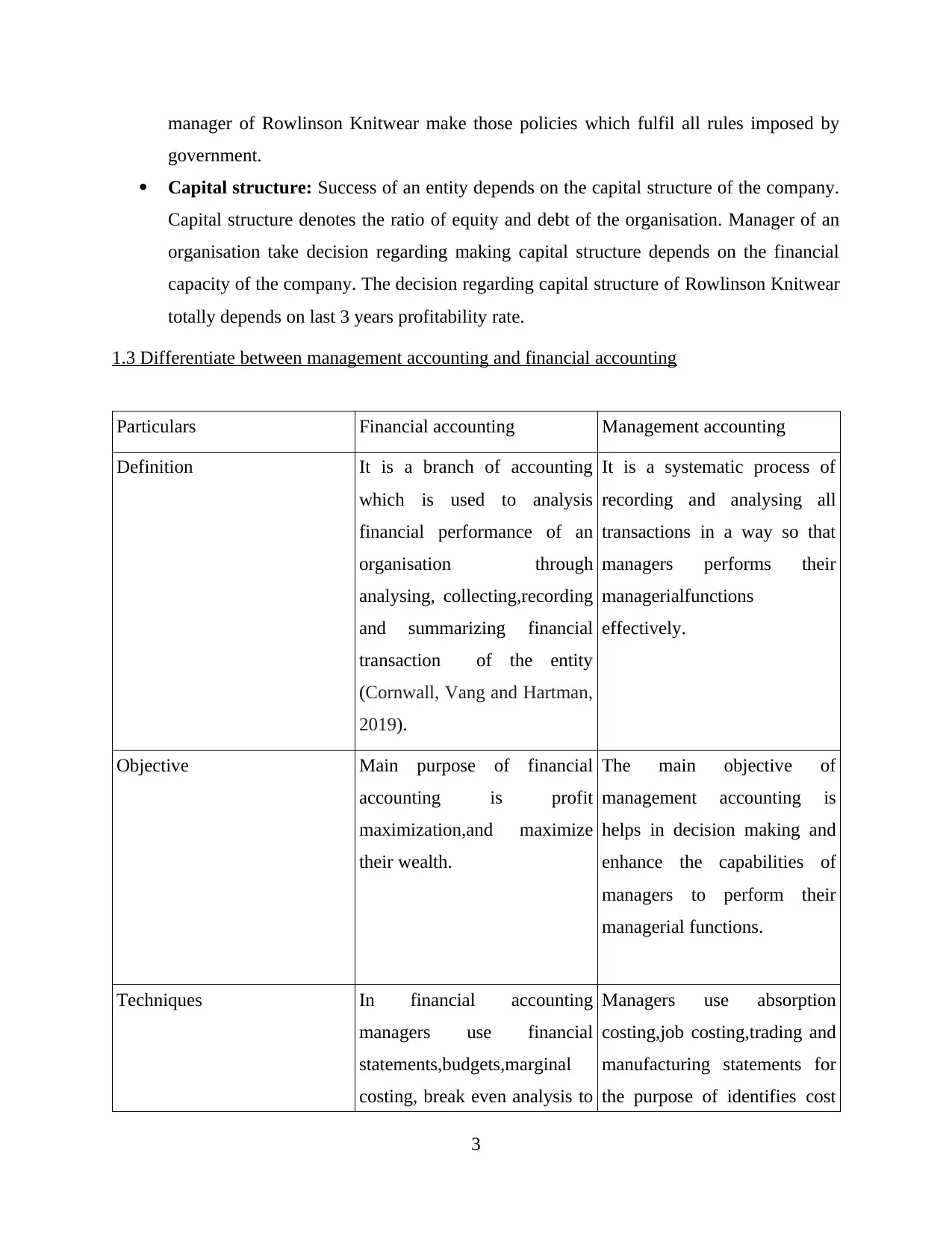
manager of Rowlinson Knitwear make those policies which fulfil all rules imposed by
government.
Capital structure: Success of an entity depends on the capital structure of the company.
Capital structure denotes the ratio of equity and debt of the organisation. Manager of an
organisation take decision regarding making capital structure depends on the financial
capacity of the company. The decision regarding capital structure of Rowlinson Knitwear
totally depends on last 3 years profitability rate.
1.3 Differentiate between management accounting and financial accounting
Particulars Financial accounting Management accounting
Definition It is a branch of accounting
which is used to analysis
financial performance of an
organisation through
analysing, collecting,recording
and summarizing financial
transaction of the entity
(Cornwall, Vang and Hartman,
2019).
It is a systematic process of
recording and analysing all
transactions in a way so that
managers performs their
managerialfunctions
effectively.
Objective Main purpose of financial
accounting is profit
maximization,and maximize
their wealth.
The main objective of
management accounting is
helps in decision making and
enhance the capabilities of
managers to perform their
managerial functions.
Techniques In financial accounting
managers use financial
statements,budgets,marginal
costing, break even analysis to
Managers use absorption
costing,job costing,trading and
manufacturing statements for
the purpose of identifies cost
3
government.
Capital structure: Success of an entity depends on the capital structure of the company.
Capital structure denotes the ratio of equity and debt of the organisation. Manager of an
organisation take decision regarding making capital structure depends on the financial
capacity of the company. The decision regarding capital structure of Rowlinson Knitwear
totally depends on last 3 years profitability rate.
1.3 Differentiate between management accounting and financial accounting
Particulars Financial accounting Management accounting
Definition It is a branch of accounting
which is used to analysis
financial performance of an
organisation through
analysing, collecting,recording
and summarizing financial
transaction of the entity
(Cornwall, Vang and Hartman,
2019).
It is a systematic process of
recording and analysing all
transactions in a way so that
managers performs their
managerialfunctions
effectively.
Objective Main purpose of financial
accounting is profit
maximization,and maximize
their wealth.
The main objective of
management accounting is
helps in decision making and
enhance the capabilities of
managers to perform their
managerial functions.
Techniques In financial accounting
managers use financial
statements,budgets,marginal
costing, break even analysis to
Managers use absorption
costing,job costing,trading and
manufacturing statements for
the purpose of identifies cost
3
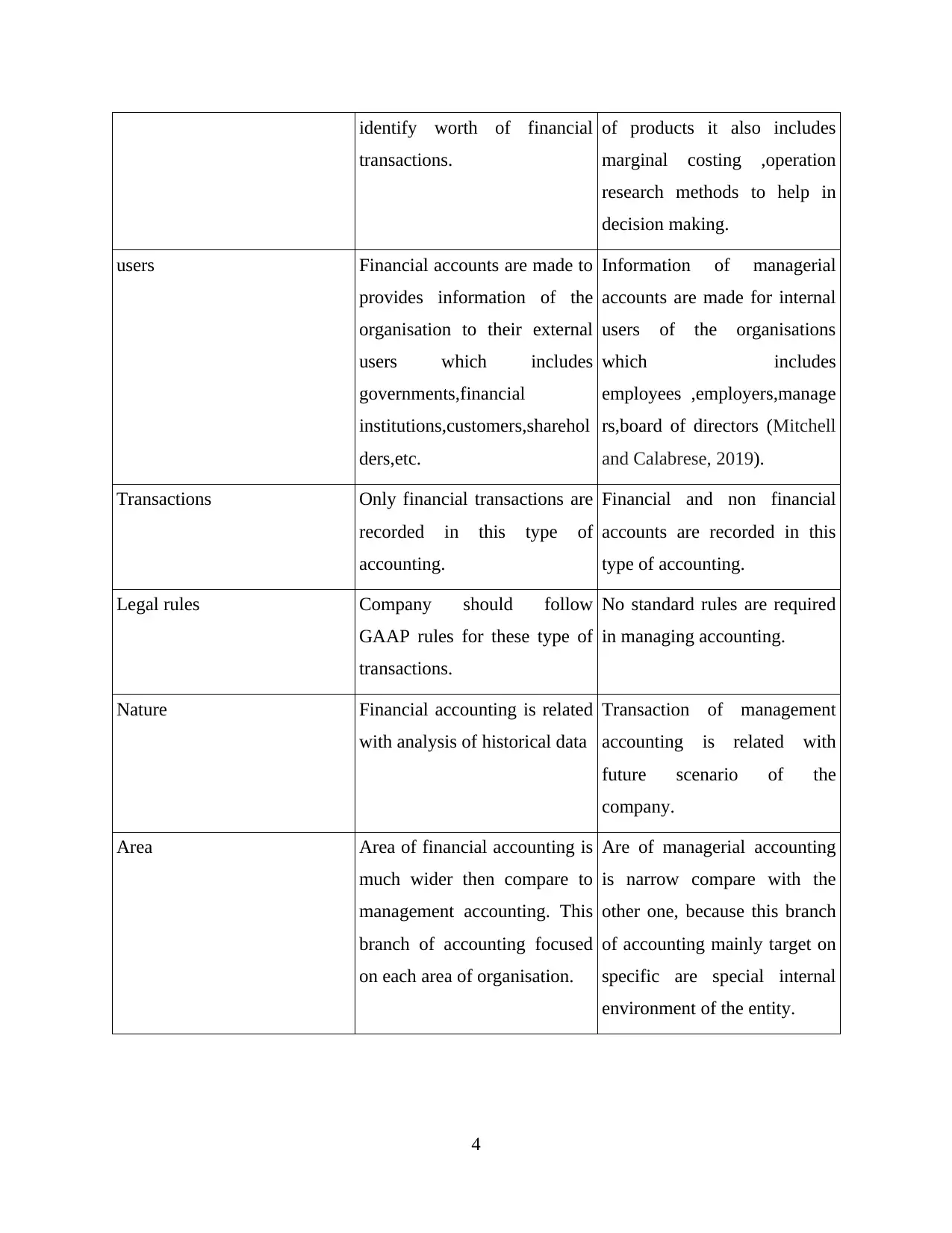
identify worth of financial
transactions.
of products it also includes
marginal costing ,operation
research methods to help in
decision making.
users Financial accounts are made to
provides information of the
organisation to their external
users which includes
governments,financial
institutions,customers,sharehol
ders,etc.
Information of managerial
accounts are made for internal
users of the organisations
which includes
employees ,employers,manage
rs,board of directors (Mitchell
and Calabrese, 2019).
Transactions Only financial transactions are
recorded in this type of
accounting.
Financial and non financial
accounts are recorded in this
type of accounting.
Legal rules Company should follow
GAAP rules for these type of
transactions.
No standard rules are required
in managing accounting.
Nature Financial accounting is related
with analysis of historical data
Transaction of management
accounting is related with
future scenario of the
company.
Area Area of financial accounting is
much wider then compare to
management accounting. This
branch of accounting focused
on each area of organisation.
Are of managerial accounting
is narrow compare with the
other one, because this branch
of accounting mainly target on
specific are special internal
environment of the entity.
4
transactions.
of products it also includes
marginal costing ,operation
research methods to help in
decision making.
users Financial accounts are made to
provides information of the
organisation to their external
users which includes
governments,financial
institutions,customers,sharehol
ders,etc.
Information of managerial
accounts are made for internal
users of the organisations
which includes
employees ,employers,manage
rs,board of directors (Mitchell
and Calabrese, 2019).
Transactions Only financial transactions are
recorded in this type of
accounting.
Financial and non financial
accounts are recorded in this
type of accounting.
Legal rules Company should follow
GAAP rules for these type of
transactions.
No standard rules are required
in managing accounting.
Nature Financial accounting is related
with analysis of historical data
Transaction of management
accounting is related with
future scenario of the
company.
Area Area of financial accounting is
much wider then compare to
management accounting. This
branch of accounting focused
on each area of organisation.
Are of managerial accounting
is narrow compare with the
other one, because this branch
of accounting mainly target on
specific are special internal
environment of the entity.
4
⊘ This is a preview!⊘
Do you want full access?
Subscribe today to unlock all pages.

Trusted by 1+ million students worldwide
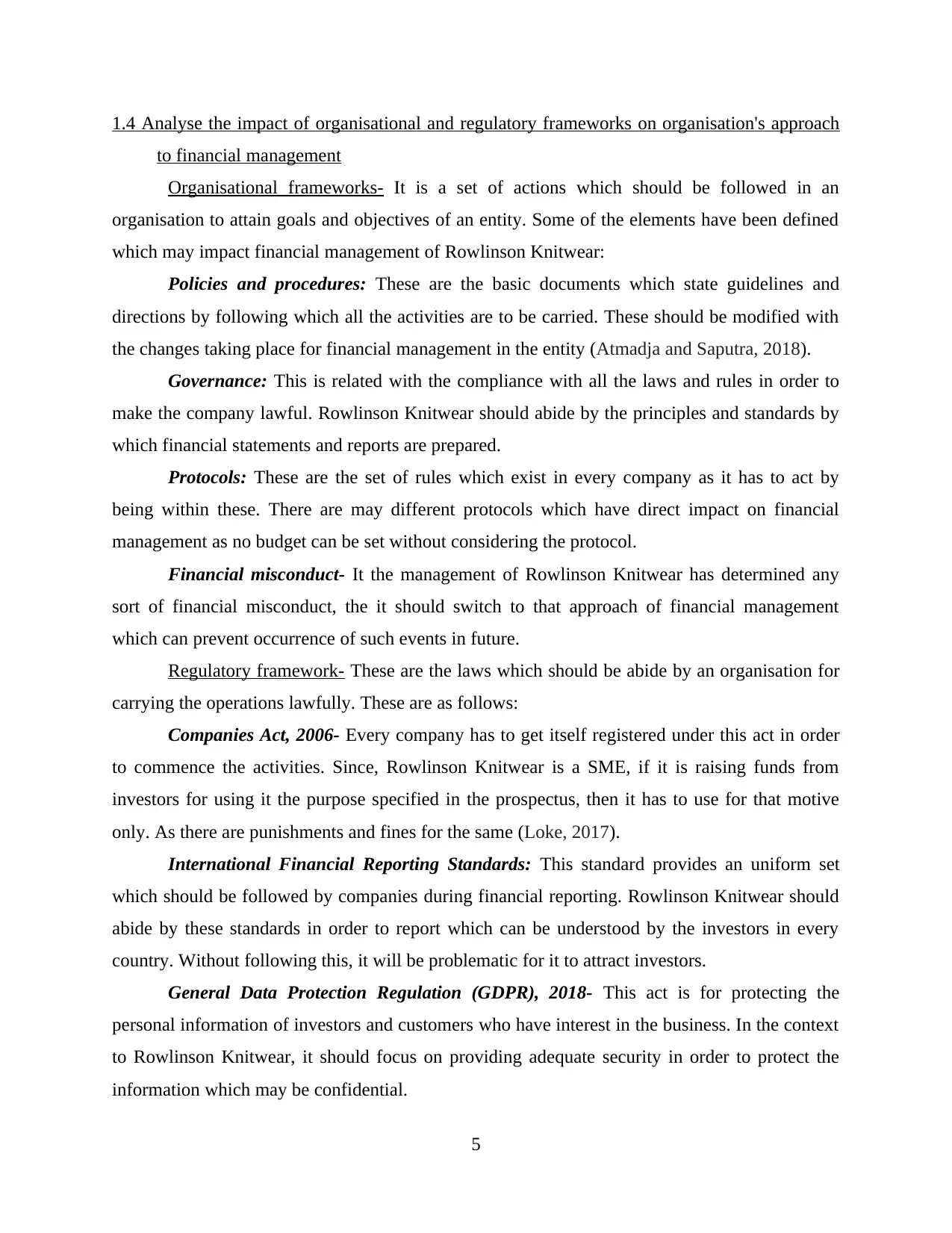
1.4 Analyse the impact of organisational and regulatory frameworks on organisation's approach
to financial management
Organisational frameworks- It is a set of actions which should be followed in an
organisation to attain goals and objectives of an entity. Some of the elements have been defined
which may impact financial management of Rowlinson Knitwear:
Policies and procedures: These are the basic documents which state guidelines and
directions by following which all the activities are to be carried. These should be modified with
the changes taking place for financial management in the entity (Atmadja and Saputra, 2018).
Governance: This is related with the compliance with all the laws and rules in order to
make the company lawful. Rowlinson Knitwear should abide by the principles and standards by
which financial statements and reports are prepared.
Protocols: These are the set of rules which exist in every company as it has to act by
being within these. There are may different protocols which have direct impact on financial
management as no budget can be set without considering the protocol.
Financial misconduct- It the management of Rowlinson Knitwear has determined any
sort of financial misconduct, the it should switch to that approach of financial management
which can prevent occurrence of such events in future.
Regulatory framework- These are the laws which should be abide by an organisation for
carrying the operations lawfully. These are as follows:
Companies Act, 2006- Every company has to get itself registered under this act in order
to commence the activities. Since, Rowlinson Knitwear is a SME, if it is raising funds from
investors for using it the purpose specified in the prospectus, then it has to use for that motive
only. As there are punishments and fines for the same (Loke, 2017).
International Financial Reporting Standards: This standard provides an uniform set
which should be followed by companies during financial reporting. Rowlinson Knitwear should
abide by these standards in order to report which can be understood by the investors in every
country. Without following this, it will be problematic for it to attract investors.
General Data Protection Regulation (GDPR), 2018- This act is for protecting the
personal information of investors and customers who have interest in the business. In the context
to Rowlinson Knitwear, it should focus on providing adequate security in order to protect the
information which may be confidential.
5
to financial management
Organisational frameworks- It is a set of actions which should be followed in an
organisation to attain goals and objectives of an entity. Some of the elements have been defined
which may impact financial management of Rowlinson Knitwear:
Policies and procedures: These are the basic documents which state guidelines and
directions by following which all the activities are to be carried. These should be modified with
the changes taking place for financial management in the entity (Atmadja and Saputra, 2018).
Governance: This is related with the compliance with all the laws and rules in order to
make the company lawful. Rowlinson Knitwear should abide by the principles and standards by
which financial statements and reports are prepared.
Protocols: These are the set of rules which exist in every company as it has to act by
being within these. There are may different protocols which have direct impact on financial
management as no budget can be set without considering the protocol.
Financial misconduct- It the management of Rowlinson Knitwear has determined any
sort of financial misconduct, the it should switch to that approach of financial management
which can prevent occurrence of such events in future.
Regulatory framework- These are the laws which should be abide by an organisation for
carrying the operations lawfully. These are as follows:
Companies Act, 2006- Every company has to get itself registered under this act in order
to commence the activities. Since, Rowlinson Knitwear is a SME, if it is raising funds from
investors for using it the purpose specified in the prospectus, then it has to use for that motive
only. As there are punishments and fines for the same (Loke, 2017).
International Financial Reporting Standards: This standard provides an uniform set
which should be followed by companies during financial reporting. Rowlinson Knitwear should
abide by these standards in order to report which can be understood by the investors in every
country. Without following this, it will be problematic for it to attract investors.
General Data Protection Regulation (GDPR), 2018- This act is for protecting the
personal information of investors and customers who have interest in the business. In the context
to Rowlinson Knitwear, it should focus on providing adequate security in order to protect the
information which may be confidential.
5
Paraphrase This Document
Need a fresh take? Get an instant paraphrase of this document with our AI Paraphraser
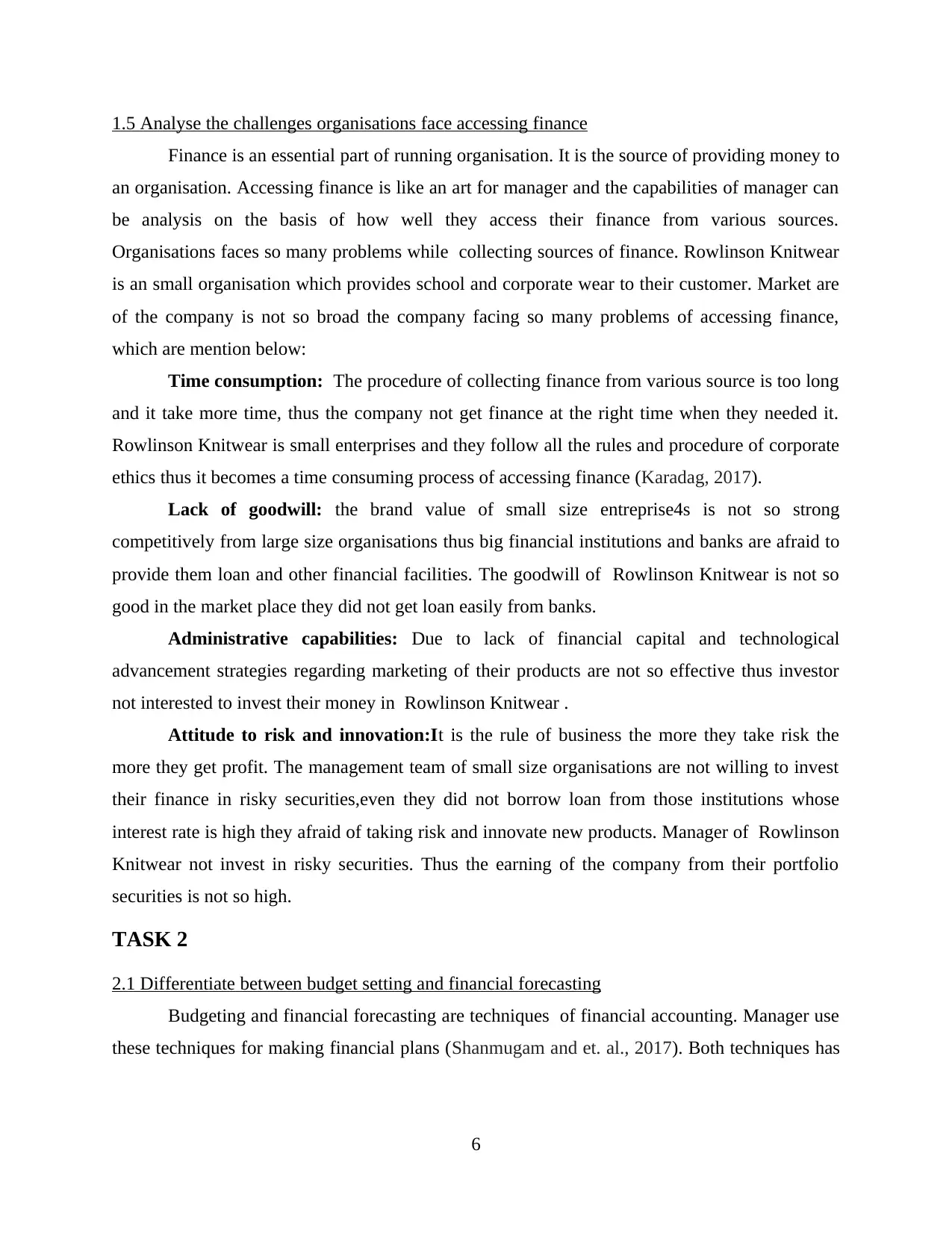
1.5 Analyse the challenges organisations face accessing finance
Finance is an essential part of running organisation. It is the source of providing money to
an organisation. Accessing finance is like an art for manager and the capabilities of manager can
be analysis on the basis of how well they access their finance from various sources.
Organisations faces so many problems while collecting sources of finance. Rowlinson Knitwear
is an small organisation which provides school and corporate wear to their customer. Market are
of the company is not so broad the company facing so many problems of accessing finance,
which are mention below:
Time consumption: The procedure of collecting finance from various source is too long
and it take more time, thus the company not get finance at the right time when they needed it.
Rowlinson Knitwear is small enterprises and they follow all the rules and procedure of corporate
ethics thus it becomes a time consuming process of accessing finance (Karadag, 2017).
Lack of goodwill: the brand value of small size entreprise4s is not so strong
competitively from large size organisations thus big financial institutions and banks are afraid to
provide them loan and other financial facilities. The goodwill of Rowlinson Knitwear is not so
good in the market place they did not get loan easily from banks.
Administrative capabilities: Due to lack of financial capital and technological
advancement strategies regarding marketing of their products are not so effective thus investor
not interested to invest their money in Rowlinson Knitwear .
Attitude to risk and innovation:It is the rule of business the more they take risk the
more they get profit. The management team of small size organisations are not willing to invest
their finance in risky securities,even they did not borrow loan from those institutions whose
interest rate is high they afraid of taking risk and innovate new products. Manager of Rowlinson
Knitwear not invest in risky securities. Thus the earning of the company from their portfolio
securities is not so high.
TASK 2
2.1 Differentiate between budget setting and financial forecasting
Budgeting and financial forecasting are techniques of financial accounting. Manager use
these techniques for making financial plans (Shanmugam and et. al., 2017). Both techniques has
6
Finance is an essential part of running organisation. It is the source of providing money to
an organisation. Accessing finance is like an art for manager and the capabilities of manager can
be analysis on the basis of how well they access their finance from various sources.
Organisations faces so many problems while collecting sources of finance. Rowlinson Knitwear
is an small organisation which provides school and corporate wear to their customer. Market are
of the company is not so broad the company facing so many problems of accessing finance,
which are mention below:
Time consumption: The procedure of collecting finance from various source is too long
and it take more time, thus the company not get finance at the right time when they needed it.
Rowlinson Knitwear is small enterprises and they follow all the rules and procedure of corporate
ethics thus it becomes a time consuming process of accessing finance (Karadag, 2017).
Lack of goodwill: the brand value of small size entreprise4s is not so strong
competitively from large size organisations thus big financial institutions and banks are afraid to
provide them loan and other financial facilities. The goodwill of Rowlinson Knitwear is not so
good in the market place they did not get loan easily from banks.
Administrative capabilities: Due to lack of financial capital and technological
advancement strategies regarding marketing of their products are not so effective thus investor
not interested to invest their money in Rowlinson Knitwear .
Attitude to risk and innovation:It is the rule of business the more they take risk the
more they get profit. The management team of small size organisations are not willing to invest
their finance in risky securities,even they did not borrow loan from those institutions whose
interest rate is high they afraid of taking risk and innovate new products. Manager of Rowlinson
Knitwear not invest in risky securities. Thus the earning of the company from their portfolio
securities is not so high.
TASK 2
2.1 Differentiate between budget setting and financial forecasting
Budgeting and financial forecasting are techniques of financial accounting. Manager use
these techniques for making financial plans (Shanmugam and et. al., 2017). Both techniques has
6
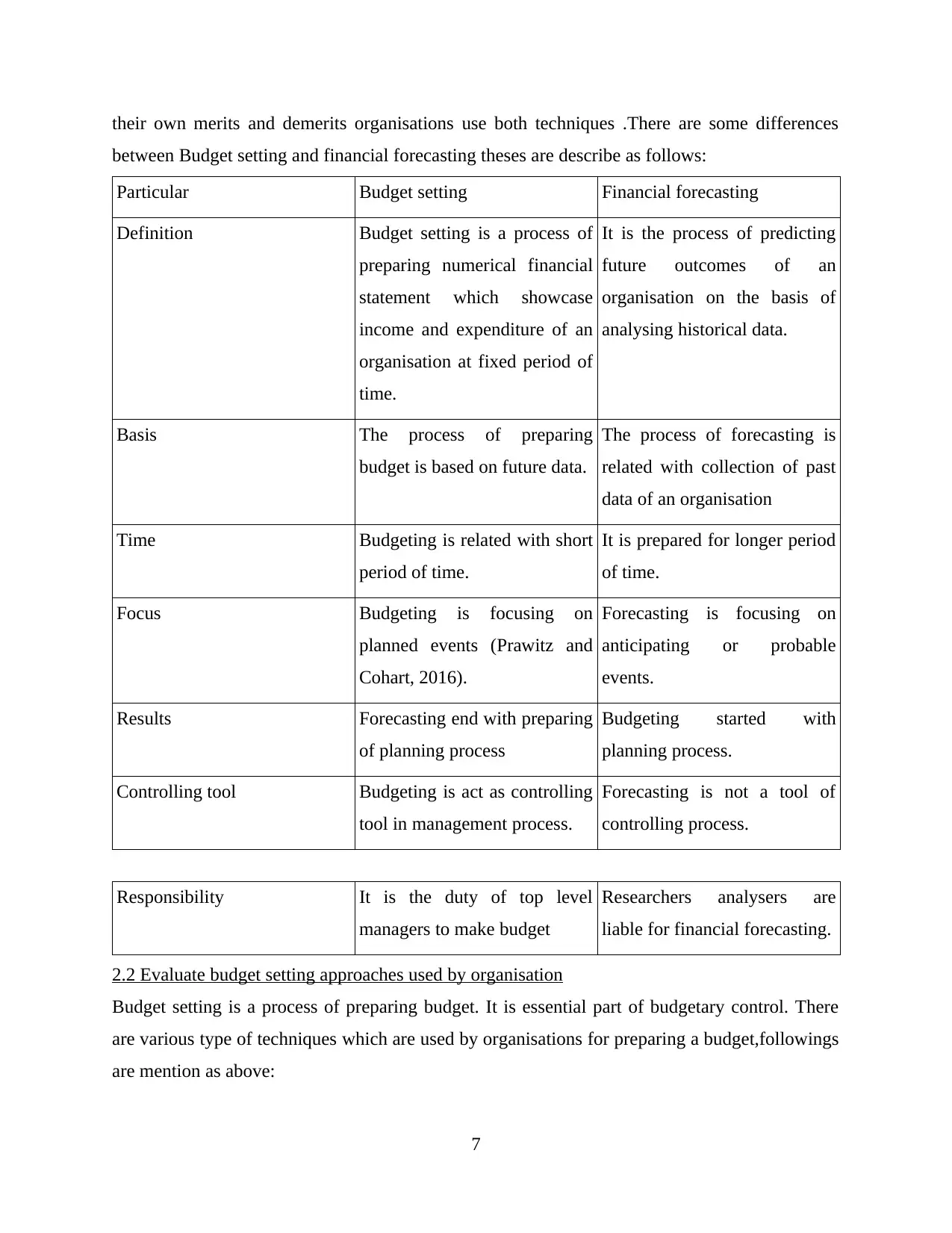
their own merits and demerits organisations use both techniques .There are some differences
between Budget setting and financial forecasting theses are describe as follows:
Particular Budget setting Financial forecasting
Definition Budget setting is a process of
preparing numerical financial
statement which showcase
income and expenditure of an
organisation at fixed period of
time.
It is the process of predicting
future outcomes of an
organisation on the basis of
analysing historical data.
Basis The process of preparing
budget is based on future data.
The process of forecasting is
related with collection of past
data of an organisation
Time Budgeting is related with short
period of time.
It is prepared for longer period
of time.
Focus Budgeting is focusing on
planned events (Prawitz and
Cohart, 2016).
Forecasting is focusing on
anticipating or probable
events.
Results Forecasting end with preparing
of planning process
Budgeting started with
planning process.
Controlling tool Budgeting is act as controlling
tool in management process.
Forecasting is not a tool of
controlling process.
Responsibility It is the duty of top level
managers to make budget
Researchers analysers are
liable for financial forecasting.
2.2 Evaluate budget setting approaches used by organisation
Budget setting is a process of preparing budget. It is essential part of budgetary control. There
are various type of techniques which are used by organisations for preparing a budget,followings
are mention as above:
7
between Budget setting and financial forecasting theses are describe as follows:
Particular Budget setting Financial forecasting
Definition Budget setting is a process of
preparing numerical financial
statement which showcase
income and expenditure of an
organisation at fixed period of
time.
It is the process of predicting
future outcomes of an
organisation on the basis of
analysing historical data.
Basis The process of preparing
budget is based on future data.
The process of forecasting is
related with collection of past
data of an organisation
Time Budgeting is related with short
period of time.
It is prepared for longer period
of time.
Focus Budgeting is focusing on
planned events (Prawitz and
Cohart, 2016).
Forecasting is focusing on
anticipating or probable
events.
Results Forecasting end with preparing
of planning process
Budgeting started with
planning process.
Controlling tool Budgeting is act as controlling
tool in management process.
Forecasting is not a tool of
controlling process.
Responsibility It is the duty of top level
managers to make budget
Researchers analysers are
liable for financial forecasting.
2.2 Evaluate budget setting approaches used by organisation
Budget setting is a process of preparing budget. It is essential part of budgetary control. There
are various type of techniques which are used by organisations for preparing a budget,followings
are mention as above:
7
⊘ This is a preview!⊘
Do you want full access?
Subscribe today to unlock all pages.

Trusted by 1+ million students worldwide
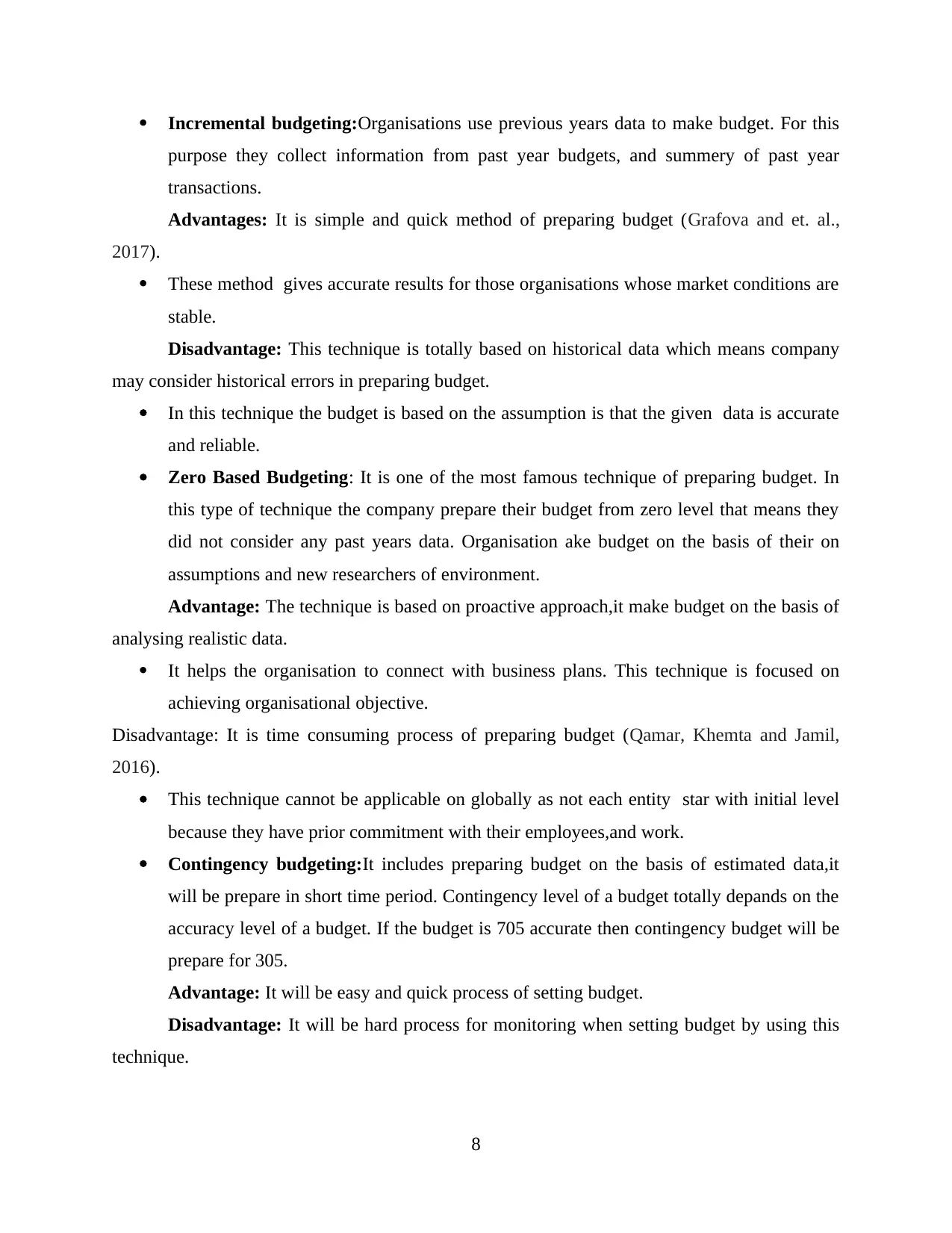
Incremental budgeting:Organisations use previous years data to make budget. For this
purpose they collect information from past year budgets, and summery of past year
transactions.
Advantages: It is simple and quick method of preparing budget (Grafova and et. al.,
2017).
These method gives accurate results for those organisations whose market conditions are
stable.
Disadvantage: This technique is totally based on historical data which means company
may consider historical errors in preparing budget.
In this technique the budget is based on the assumption is that the given data is accurate
and reliable.
Zero Based Budgeting: It is one of the most famous technique of preparing budget. In
this type of technique the company prepare their budget from zero level that means they
did not consider any past years data. Organisation ake budget on the basis of their on
assumptions and new researchers of environment.
Advantage: The technique is based on proactive approach,it make budget on the basis of
analysing realistic data.
It helps the organisation to connect with business plans. This technique is focused on
achieving organisational objective.
Disadvantage: It is time consuming process of preparing budget (Qamar, Khemta and Jamil,
2016).
This technique cannot be applicable on globally as not each entity star with initial level
because they have prior commitment with their employees,and work.
Contingency budgeting:It includes preparing budget on the basis of estimated data,it
will be prepare in short time period. Contingency level of a budget totally depands on the
accuracy level of a budget. If the budget is 705 accurate then contingency budget will be
prepare for 305.
Advantage: It will be easy and quick process of setting budget.
Disadvantage: It will be hard process for monitoring when setting budget by using this
technique.
8
purpose they collect information from past year budgets, and summery of past year
transactions.
Advantages: It is simple and quick method of preparing budget (Grafova and et. al.,
2017).
These method gives accurate results for those organisations whose market conditions are
stable.
Disadvantage: This technique is totally based on historical data which means company
may consider historical errors in preparing budget.
In this technique the budget is based on the assumption is that the given data is accurate
and reliable.
Zero Based Budgeting: It is one of the most famous technique of preparing budget. In
this type of technique the company prepare their budget from zero level that means they
did not consider any past years data. Organisation ake budget on the basis of their on
assumptions and new researchers of environment.
Advantage: The technique is based on proactive approach,it make budget on the basis of
analysing realistic data.
It helps the organisation to connect with business plans. This technique is focused on
achieving organisational objective.
Disadvantage: It is time consuming process of preparing budget (Qamar, Khemta and Jamil,
2016).
This technique cannot be applicable on globally as not each entity star with initial level
because they have prior commitment with their employees,and work.
Contingency budgeting:It includes preparing budget on the basis of estimated data,it
will be prepare in short time period. Contingency level of a budget totally depands on the
accuracy level of a budget. If the budget is 705 accurate then contingency budget will be
prepare for 305.
Advantage: It will be easy and quick process of setting budget.
Disadvantage: It will be hard process for monitoring when setting budget by using this
technique.
8
Paraphrase This Document
Need a fresh take? Get an instant paraphrase of this document with our AI Paraphraser
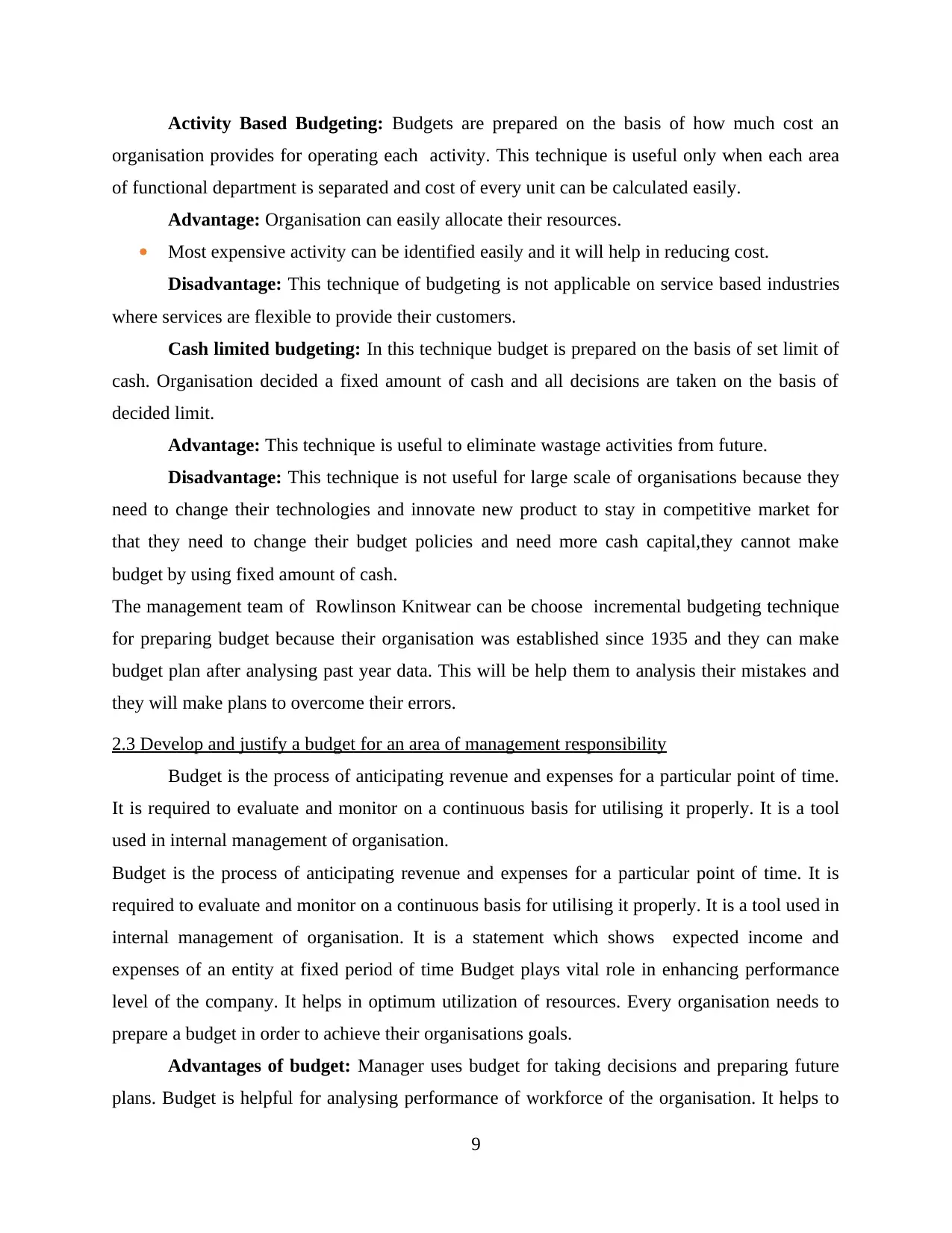
Activity Based Budgeting: Budgets are prepared on the basis of how much cost an
organisation provides for operating each activity. This technique is useful only when each area
of functional department is separated and cost of every unit can be calculated easily.
Advantage: Organisation can easily allocate their resources.
Most expensive activity can be identified easily and it will help in reducing cost.
Disadvantage: This technique of budgeting is not applicable on service based industries
where services are flexible to provide their customers.
Cash limited budgeting: In this technique budget is prepared on the basis of set limit of
cash. Organisation decided a fixed amount of cash and all decisions are taken on the basis of
decided limit.
Advantage: This technique is useful to eliminate wastage activities from future.
Disadvantage: This technique is not useful for large scale of organisations because they
need to change their technologies and innovate new product to stay in competitive market for
that they need to change their budget policies and need more cash capital,they cannot make
budget by using fixed amount of cash.
The management team of Rowlinson Knitwear can be choose incremental budgeting technique
for preparing budget because their organisation was established since 1935 and they can make
budget plan after analysing past year data. This will be help them to analysis their mistakes and
they will make plans to overcome their errors.
2.3 Develop and justify a budget for an area of management responsibility
Budget is the process of anticipating revenue and expenses for a particular point of time.
It is required to evaluate and monitor on a continuous basis for utilising it properly. It is a tool
used in internal management of organisation.
Budget is the process of anticipating revenue and expenses for a particular point of time. It is
required to evaluate and monitor on a continuous basis for utilising it properly. It is a tool used in
internal management of organisation. It is a statement which shows expected income and
expenses of an entity at fixed period of time Budget plays vital role in enhancing performance
level of the company. It helps in optimum utilization of resources. Every organisation needs to
prepare a budget in order to achieve their organisations goals.
Advantages of budget: Manager uses budget for taking decisions and preparing future
plans. Budget is helpful for analysing performance of workforce of the organisation. It helps to
9
organisation provides for operating each activity. This technique is useful only when each area
of functional department is separated and cost of every unit can be calculated easily.
Advantage: Organisation can easily allocate their resources.
Most expensive activity can be identified easily and it will help in reducing cost.
Disadvantage: This technique of budgeting is not applicable on service based industries
where services are flexible to provide their customers.
Cash limited budgeting: In this technique budget is prepared on the basis of set limit of
cash. Organisation decided a fixed amount of cash and all decisions are taken on the basis of
decided limit.
Advantage: This technique is useful to eliminate wastage activities from future.
Disadvantage: This technique is not useful for large scale of organisations because they
need to change their technologies and innovate new product to stay in competitive market for
that they need to change their budget policies and need more cash capital,they cannot make
budget by using fixed amount of cash.
The management team of Rowlinson Knitwear can be choose incremental budgeting technique
for preparing budget because their organisation was established since 1935 and they can make
budget plan after analysing past year data. This will be help them to analysis their mistakes and
they will make plans to overcome their errors.
2.3 Develop and justify a budget for an area of management responsibility
Budget is the process of anticipating revenue and expenses for a particular point of time.
It is required to evaluate and monitor on a continuous basis for utilising it properly. It is a tool
used in internal management of organisation.
Budget is the process of anticipating revenue and expenses for a particular point of time. It is
required to evaluate and monitor on a continuous basis for utilising it properly. It is a tool used in
internal management of organisation. It is a statement which shows expected income and
expenses of an entity at fixed period of time Budget plays vital role in enhancing performance
level of the company. It helps in optimum utilization of resources. Every organisation needs to
prepare a budget in order to achieve their organisations goals.
Advantages of budget: Manager uses budget for taking decisions and preparing future
plans. Budget is helpful for analysing performance of workforce of the organisation. It helps to
9
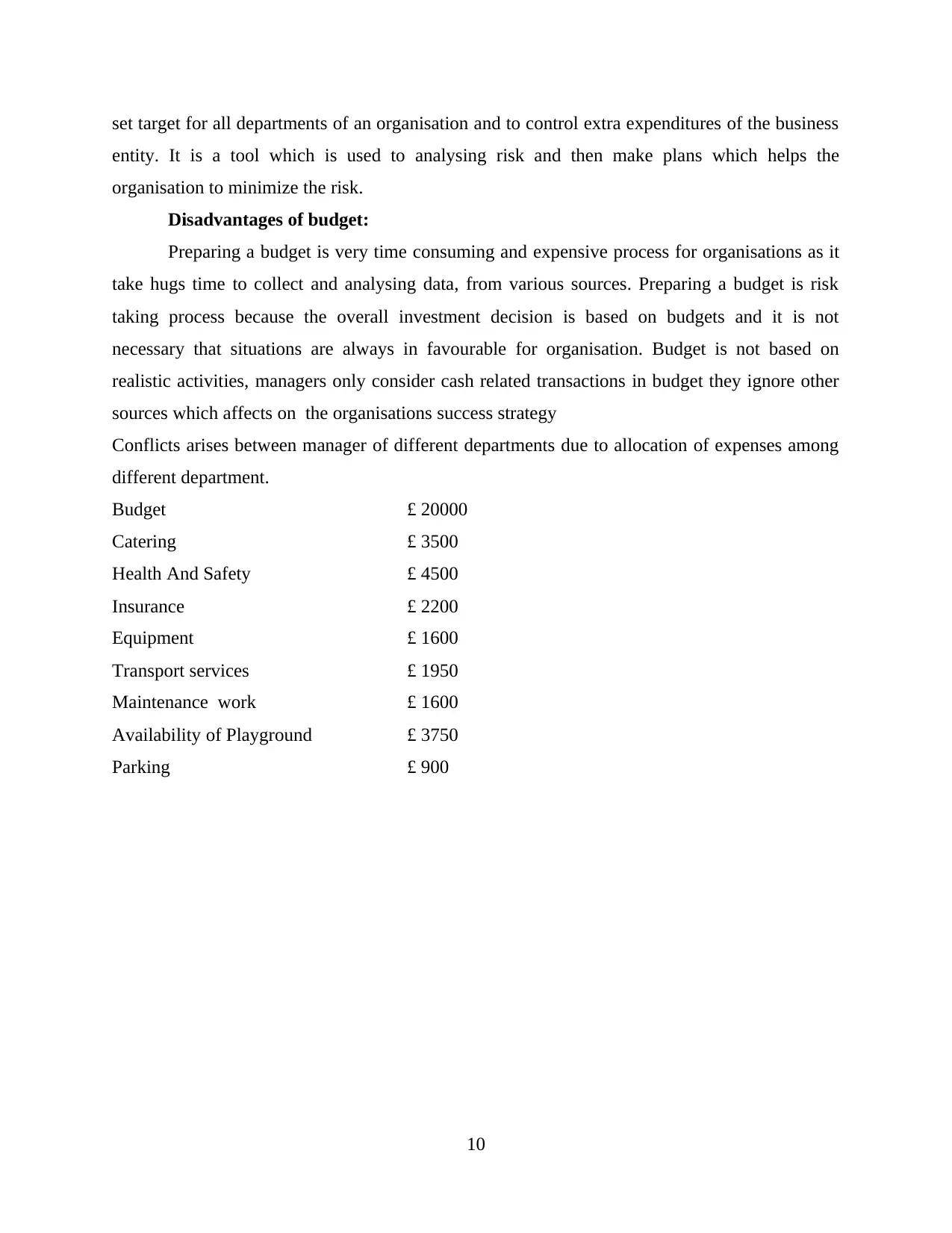
set target for all departments of an organisation and to control extra expenditures of the business
entity. It is a tool which is used to analysing risk and then make plans which helps the
organisation to minimize the risk.
Disadvantages of budget:
Preparing a budget is very time consuming and expensive process for organisations as it
take hugs time to collect and analysing data, from various sources. Preparing a budget is risk
taking process because the overall investment decision is based on budgets and it is not
necessary that situations are always in favourable for organisation. Budget is not based on
realistic activities, managers only consider cash related transactions in budget they ignore other
sources which affects on the organisations success strategy
Conflicts arises between manager of different departments due to allocation of expenses among
different department.
Budget £ 20000
Catering £ 3500
Health And Safety £ 4500
Insurance £ 2200
Equipment £ 1600
Transport services £ 1950
Maintenance work £ 1600
Availability of Playground £ 3750
Parking £ 900
10
entity. It is a tool which is used to analysing risk and then make plans which helps the
organisation to minimize the risk.
Disadvantages of budget:
Preparing a budget is very time consuming and expensive process for organisations as it
take hugs time to collect and analysing data, from various sources. Preparing a budget is risk
taking process because the overall investment decision is based on budgets and it is not
necessary that situations are always in favourable for organisation. Budget is not based on
realistic activities, managers only consider cash related transactions in budget they ignore other
sources which affects on the organisations success strategy
Conflicts arises between manager of different departments due to allocation of expenses among
different department.
Budget £ 20000
Catering £ 3500
Health And Safety £ 4500
Insurance £ 2200
Equipment £ 1600
Transport services £ 1950
Maintenance work £ 1600
Availability of Playground £ 3750
Parking £ 900
10
⊘ This is a preview!⊘
Do you want full access?
Subscribe today to unlock all pages.

Trusted by 1+ million students worldwide
1 out of 15
Related Documents
Your All-in-One AI-Powered Toolkit for Academic Success.
+13062052269
info@desklib.com
Available 24*7 on WhatsApp / Email
![[object Object]](/_next/static/media/star-bottom.7253800d.svg)
Unlock your academic potential
Copyright © 2020–2025 A2Z Services. All Rights Reserved. Developed and managed by ZUCOL.





